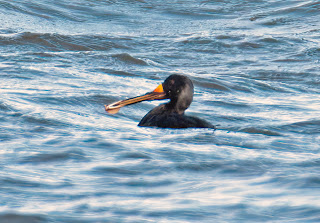NATURE MONCTON NATURE NEWS
December
1, 2023
To respond
by e-mail, please address your message to the information line editor, nelsonpoirier435@gmail.com .
Please
advise both the editor at nelsonpoirier435@gmail.com and the proofreader nicholsl@eastlink.ca if any errors are noted in wording or
photo labelling.
For more information on Nature Moncton, check the website at www.naturemoncton.com .
Edited by
Nelson Poirier nelsonpoirier435@gmail.com
Proofreading
courtesy of Louise Nichols at nicholsl@eastlink.ca
**Jane LeBlanc got a quick look at a female Pileated
Woodpecker on top of the hydro pole by the garage in her St. Martins yard
and got a documentary photo before it flew.
**This year’s Moncton Christmas Bird Count (CBC)
will be held on Saturday, December 16, 2023.
Those who have not previously participated in
the important Feeder Count but wish to do so this year may contact feeder Count
coordinator Susan Atkinson at susandatkinson@outlook.com
and she will forward the information sheets and reporting form to you.
(Editor’s note: feeder yard observations are a
very important part of the Christmas Bird Count as this is where birds tend to
collect and in the past, some very significant additions have been made to the
tally by those watching right from home and reporting what they see.)
**With today being the start of December, Gilles Belliveau will again take care of the NB Winter Bird list.
Gilles will once again be compiling the list of the birds seen in NB from Dec 1, 2023, to Feb 29, 2024, and the list can be seen at the following website.
Gilles will be monitoring the nbListserv, eBird, Discord, Messenger Groups, and Facebook groups for observations but you can also email Gilles with your observations if you prefer at gilles.belliveau@gmail.com
**Fred Dube was able to get clear photos of tracks in the snow he noted in his Lower Coverdale yard, which are very suggestive of a Weasel.
(Editor’s note: it can be a great time of year to photograph tracks in light snowfalls that stay for a few days and don’t get distorted when the temperature rises as may happen today. It is helpful to get an actual measurement of the track and the distance between them.)
**When Brian Stone was out along the shore on
Tuesday, he got a photo of an adult male Black Scoter with what appears
to be a long Razor Clam in its bill.
It seems like very large prey to make its way down, but I suspect the bird knows
exactly how to handle it.
**It’s
Friday and time to get a preview of what next week’s night sky may have in
store for us courtesy of sky guru Curt Nason.
This
Week’s Sky at a Glance, 2023 December 2 – December 9
Soon many naturalists throughout the province will be busy performing Christmas
bird counts. If you are on your toes and not too worn out you can add four
stellar birds between dusk and dawn. Start with the easy ones around 6 pm by
looking for the three bright stars of the Summer Triangle above the
western horizon. The lowest of the three is Altair, the head of Aquila the
Eagle, which is standing straight up on the horizon. The highest of the trio is
Deneb at the tail of Cygnus the Swan, which is doing its signature dive. The
third member is Lyra the Harp with its bright star Vega to the right of Altair.
A few centuries ago celestial cartographers depicted the harp in the talons of
an eagle or vulture, so maybe we can claim that as a fifth bird.
Midnight is your best chance to spot the elusive and tiny Columba the Dove, but
you will need an unobstructed southern horizon. Look below Orion for Lepus the
Hare, and then try to see stars near the horizon directly below. Very few bird
counts will be missing the common crow but, in case you did, look about a hand
span above the southern horizon around 6:30 am for a distinct quadrilateral of
stars. There you will find Corvus the Crow hitching a ride on the tail of Hydra
the Water Snake.
This Week in the Solar System
Saturday’s sunrise in Moncton is at 7:41 and sunset will occur at 4:34, giving
8 hours, 53 minutes of daylight (7:43 and 4:42 in Saint John). Next Saturday
the Sun will rise at 7:49 and set at 4:33, giving 8 hours, 44 minutes of
daylight (7:51 and 4:41 in Saint John). We are at that period when the Sun sets
around the same time for two weeks, although day length continues to decrease
until the solstice.
The Moon is near Regulus in Leo this Sunday and reaches third quarter phase
early on Tuesday. Next Friday and Saturday mornings it passes below Spica and
Venus, respectively. Saturn is highest in evening twilight, setting around
11 pm. Tuesday is a busy evening for Jupiter watchers, with Ganymede
reappearing from the planet’s shadow at 5:40, Europa’s shadow transiting
between 8:55 and 11:15, and Io disappearing behind Jupiter at 10:36 when the
planet is near its highest. Mercury is at its farthest from the Sun in the
evening sky on Monday, setting at 5:50, so this is the best week to see it with
binoculars. Venus is near Spica in the morning sky this weekend, slowing
moving sunward.
The Saint John Astronomy Club meets in the Rockwood Park Interpretation Centre
on December 2 at 7pm. On Sunday evening at 8 pm, tune in to the Sunday Night
Astronomy Show via the Facebook page or YouTube channel of Astronomy by the
Bay.
Nelson Poirier
Nature Moncton

.%20NOV.%2030,%202023.%20JANE%20LEBLANC.JPG)
.NOV30,%202023.%20FRED%20DUBE%20(3).jpg)
.NOV30,%202023.%20%20FRED%20DUBE%20(3).jpg)
.NOV30,%202023.%20.FRED%20DUBE%20(3).jpg)
